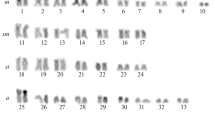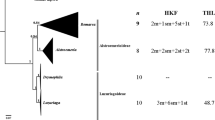Abstract
Eight taxa of the genus Bellevalia (Hyacinthaceae) occurring in Greece, all with basic chromosome number x = 4, were cytologically studied using classical and molecular-cytogenetic techniques [fluorochrome banding with chromomycin A3, fluorescence in situ hybridization (FISH) using probes of 18S–5.8S–26S and 5S ribosomal RNA genes]. Two of the examined taxa are endemic, i.e., B. brevipedicellata and B. sitiaca, both restricted to the Island of Kriti. B. hyacinthoides and B. edirnensis are Balkan endemics, and the four remaining taxa, i.e., B. dubia subsp. boissieri, B. trifoliata, B. romana, and B. ciliata, are more widely distributed Mediterranean elements. Genome size, estimated by flow cytometry, ranged from 18.59 to 53.38 pg. The results of fluorochrome banding and FISH are reported for the first time for the genus Bellevalia. Despite the morphological similarity of the chromosome complement, which is in accordance with the general “basic” Bellevalia karyotype formula, the karyotypes of the studied species are clearly distinguished by the number and position of GC-rich bands and ribosomal DNA (rDNA) loci, revealing clear interspecific differentiation among the taxa. Additionally, examination of the polyploid species B. sitiaca and B. edirnensis and populations of B. hyacinthoides and B. ciliata with different ploidy levels permits discussion about the origin of polyploids and the taxonomic relationships among the taxa.



Similar content being viewed by others
References
Abbo S, Miller TE, Reader SM, Dunford RP, King IP (1994) Detection of ribosomal DNA in lentil and chickpea by fluorescence in situ hybridization. Genome 37:713–716
Bareka P (2008) A biosystematic study of Bellevalia taxa (Hyacinthaceae). PhD thesis, University of Patras, Greece (in Greek with English summary)
Bareka P, Phitos D, Kamari G (2008) A karyosystematic study of the genus Bellevalia Lapeyr. (Hyacinthaceae) in Greece. Bot J Linn Soc 157:723–739
Bennetzen JL (2002) Mechanisms and rates of genome expansion and contraction in flowering plants. Genetica 115:29–36
Bennetzen JL, Ma J, Devos KM (2005) Mechanisms of recent genome size variation in flowering plants. Ann Bot 95:127–132
Benzer B, von Bothmer R, Engstrand L, Gustavsson M, Snogerup S (1971) Some sources of error in the determinations of arm ratios of chromosomes. Bot Notiser 124:65–74
Bothmer R, von Wendelbo P (1981) Cytological and morphological variation in Bellevalia. Nordic J Bot 1:4–11
Bou Dagher-Kharrat M, Grenier G, Bariteau M, Brown S, Siljak-Yakovlev S, Savouré A (2001) Karyotype analysis reveals interspecific differentiation in the genus Cendrus despite genome size and base composition constancy. Theor Appl Genet 103:846–854
Brullo C, Brullo S, Pasta S (2009) Bellevalia pelagica (Hyacinthaceae), a new species from the islet of Lampione (Pelagian Archipelago, Sicily). Edinb J Bot 66(1):65–75
Capineri R, d’Amato G, Marchi P (1978) Numeri cromosomici per la flora Italiana: 534–583. Inform Bot Ital 10:421–465
Cerbach M, Coulaud J, Siljak-Yakovlev S (1998) rDNA organization and evolutionary relationships in the genus Hypochaeris (Asteraceae). J Hered 89(4):312–318
Chiarugi A (1949) Saggio di una revisione citosistematica della flora Italiana. Caryologia 1:362–377
Chiche J, Brown SC, Leclerc JC, Siljak-Yakovlev S (2003) Genome size, heterochromatin organization, and ribosomal gene mapping in four species of Ribes. Can J Bot 81:1049–1057
Constantinidis Th, Kamari G, Phitos D (1997) A cytological study of 28 phanerogams from the mountains of SE Sterea Hellas, Greece. Willdenowia 27:121–142
Constantinidis Th, Bareka EP, Kamari G (2002) Karyotaxonomy of Greek serpentine angiosperms. Bot J Linn Soc 139:109–124
Doležel J, Lucretti S, Schubert I (1994) Plant chromosome analysis and sorting by flow cytometry. CRC Crit Rev Plant Sci 13:275–309
Duchoslav M, Šafářová L, Krahulec F (2010) Complex distribution patterns, ecology and coexistence of ploidy levels of Allium oleraceum (Alliaceae) in the Czech Republic. Ann Bot 105:719–735
Favarger C (1978) Philosophie des comptages de chromosome. Taxon 27:441–448
Feinbrun N (1938–1940) A monographic study on the genus Bellevalia Lapeyr. (Caryology, taxonomy, geography). Palest J Bot, Jer Ser 1:42–54, 131–142, 336–409
Fukui K, Kamisuki Y, Sakai F (1994) Physical mapping of 5S rDNA loci by direct-cloned biotinylated probes in barley chromosomes. Genome 37:105–111
Galbraith DW, Harkins KR, Maddox JM, Ayres NM, Sharma DP, Firoozabady E (1983) Rapid flow cytometric analysis of the cell cycle in intact plant tissues. Science 220:1049–1051
Garbari F (1981) Il cariotipo-typus, nuovo concetto della citosistematica. Acta Biologica 58:255–264
Garcia S, Garnatje T, Hidalgo O, Mcarthur ED, Siljak-Yakovlev S, Vallès J (2007) Extensive ribosomal DNA (18S–5.8S–26S and 5S) colocalization in the North American endemic sagebrushes (subgenus Tridentatae, Artemisia, Asteraceae) revealed by FISH. Plant Syst Evol 267:79–92
Garnatje T, Vallès J, Vilatersana R, Susanna A, Garcia-Jacas N, Siljak-Yakovlev S (2004) Molecular cytogenetics of Xeranthemum L. and related genera (Asteraceae, Cardueae). Plant Biol 6:140–146
Gerlach WL, Dyer TA (1980) Sequence organization of the repeating units in the nucleus of wheat, which contain 5S rRNA genes. Nucleic Acids Res 8(21):4851–4865
Gettner ME (2005) Variable karyotype with B-chromosomes in Bellevalia saviszii (Liliaceae). Genetica 124:223–234
Gregory TR (2005) The C-value enigma in plants and animals: a review of parallels and an appeal for partnership. Ann Bot 95:133–146
Greilhuber J, Doležel J, Lysàk MA, Bennett MD (2005) The origin, evolution and proposed stabilization of the terms ‘genome size’ and ‘C-value’ to describe nuclear DNA contents. Ann Bot 95:255–260
Hadač E (1989) Ecological significance of polyploidy in high mountain plants and plant communities. Folia Geobot Phytotax 24(1):51–56
Heslop-Harrison JS, Schwarzacher T, Anamthawat-Jónsson K, Leitch AR, Shi M, Leitch IJ (1991) In situ hybridization with automated chromosome denaturation. Technique 3:109–115
Hidalgo O, Garcia-Jacas N, Garnatje T, Romashchenko K, Susanna A, Siljak-Yakovlev S (2008) Extreme environmental conditions and phylogenetic inheritance: systematics of Myopordon and Oligochaeta (Asteraceae, Cardueae–Centaureinae). Taxon 57:769–778
Hizume M (1992) Exact location of rRNA genes in Vicia faba chromosomes. Cytologia 57:471–475
Jakob SS, Meister A, Blattner RF (2004) The considerable genome size variation of Hordeum species (Poaceae) is linked to phylogeny, life form, ecology and speciation rates. Mol Biol Evol 21:860–869
Johnson MAT (2003) Polyploidy and karyotype variation in Turkish Bellevalia (Hyacinthaceae). Bot J Linn Soc 143:87–98
Johnson MAT, Brandham PE (1997) New chromosome numbers in petaloid monocotyledons and in other miscellaneous angiosperms. Kew Bull 52(1):121–136
Kamari G (1976) Cytotaxonomic study of the Crepis neglecta L. complex in Greece. PhD thesis, University of Patras, Patras, Greece (in Greek with English summary)
Kamisuki Y, Nakayama S, Nakayama R, Ohtsubo H, Ohtsubo E, Fukui K (1994) Physical mapping of the 5S ribosomal RNA genes on rice chromosome 11. Mol Gen Genet MGG 245:33–138
Leitch IJ, Heslop-Harisson JS (1992) Physical mapping of 18S–5.8S–28S r RNA genes in barley by in situ hybridization. Genome 35:1013–1018
Leitch IJ, Bennett MD (2004) Genome downsizing in polyploid plants. Biol J Linn Soc 82:651–663
Levan A, Fredga K, Sandberg AA (1964) Nomenclature for centromeric position on chromosomes. Hereditas 52:201–220
Marie D, Brown SC (1993) A cytometric exercise in plant DNA histograms, with 2C values for 70 species. Biol Cell 78:41–51
Murata M, Heslop-Harrison JS, Motoyoshi F (1997) Physical mapping of the 5S ribosomal RNA genes in Arabidopsis thaliana by multi-color fluorescence in situ hybridization with cosmid clones. Plant J 12:31–37
Muratović E, Bogunić F, Šoljan D, Siljak-Yakovlev S (2005) Does Lilium bosniacum merit a species rank? A classical and molecular-cytogenetic analysis. Plant Syst Evol 252:97–109
Musano L, Maggini F (1976) Triploidia in Bellevalia dubia (Guss.) Roemer & Schultes. Inform Bot Ital 8:186
Özhatay N, Johnson MAT, Mathew B (1991a) Chromosome numbers of Turkish Bellevalia species, including a new hexaploid from European Turkey. Bot Chron 10:813–818
Özhatay N, Johnson MAT, Mathew B, Dalgiç G (1991b) A new hexaploid Bellevalia (Hyacinthaceae) from European Turkey. Bot J Linn Soc 107:89–99
Özhatay N, Johnson MAT (1996) Some karyological remarks on Turkish Allium sect. Allium, Bellevalia, Muscari and Ornithogalum subg. Ornithogalum. Bocconea 5:239–249
Persson K, Wendelbo P (1979) Bellevalia hyacinthoides, a new name for Strangweia spicata (Liliaceae). Bot Notiser 132:65–70
Phitos D (1988) Chromosome numbers in some species of the Greek flora. Bot Chron 8:45–50
Pogosyan AI (1975) A karyosystematic study of the genus Bellevalia Lapeyr. Flora, Plant Life and Plant Resources of the Armenian SSR, Part 6:12–26 (in Russian)
Pogosyan AI, Torosyan GK (1983) Comparative analysis of chromosomes of diploid and triploid cytotypes of Bellevalia sarmatica (Pall.) Woronow (Liliaceae). Citologia Genetika (Kiev) 17:9–14 (in Russian with English summary)
Schweizer D (1976) Reverse fluorescent chromosome banding with chromomycin and DAPI. Chromosoma 58:307–324
Shuka L (2010) Bellevalia hyacinthoides, new species for the Albanian flora. Nat Monten 9(3):417–420
Siljak-Yakovlev S, Cerbah M, Zoldoš V, Godelle B (1998) Heterochromatin and rDNA organisation and evolution in the genus Reichardia. Cytogenet Cell Genet 81:114
Siljak-Yakovlev S, Cerbah M, Coulaud J, Stoian V, Brown SC, Zoldoš V, Jelenic S, Papeš D (2002) Nuclear DNA content, base composition, heterochromatin and rDNA in Picea omorika and Picea abies. Theor Appl Genet 104:505–512
Siljak-Yakovlev S, Peccenini S, Muratović E, Zoldoš V, Robin O, Vallès J (2003) Chromosomal differentiation and genome size in three European mountain Lilium species. Plant Syst Evol 236:165–173
Srisuwan S, Sihachakr D, Siljak-Yakovlev S (2006) Origin and evolution of sweet potato (Ipomoea batatas Lam.) and its wild relatives through the cytogenetic approaches. Plant Sci 171:424–433
Stebbins GL (1971) Chromosomal evolution in higher plants. Edward Arnold, London
Sybenga J (1959) Some sources of error in the determination of chromosome length. Chromosoma 10:355–364
Torrell M, Cerbah M, Siljak-Yakovlev S, Vallès J (2003) Molecular cytogenetics of the genus Artemisia (Asteraceae Anthemideae). Fluorochrome banding and fluorescence in situ hybridization. Part I. Subgenus Seriphidium and related taxa. Plant Syst Evol 239:141–153
Weiss-Schneeweiss H, Stuessy TF, Siljak-Yakovlev S, Baeza CM, Paker J (2003) Karyotype evolution in South American species of Hypochaeris (Asteraceae, Lactuceae). Plant Syst Evol 241:171–184
Wendelbo P (1980) Notes on Hyacinthus and Bellevalia (Liliaceae) in Turkey and Iran. Notes RBG Edinb 38(3):423–434
Zakhariyeva OI, Makushenko LM (1969) Chromosome numbers of monocotyledons belonging to the families Liliaceae, Iridaceae, Amaryllidaceae and Araceae. Bot Zhurn 54:1213–1227
Zoldos V, Papeš D, Cerbah M, Panaud O, Besendorfer V, Siljak-Yakovlev S (1999) Molecular cytogenetic studies of ribosomal genes and heterochromatin reveal conserved genome organization among 11 Quercus species. Theor Appl Genet 99:969–977
Author information
Authors and Affiliations
Corresponding author
Rights and permissions
About this article
Cite this article
Bareka, P., Siljak-Yakovlev, S. & Kamari, G. Molecular cytogenetics of Bellevalia (Hyacinthaceae) species occurring in Greece. Plant Syst Evol 298, 421–430 (2012). https://doi.org/10.1007/s00606-011-0555-7
Received:
Accepted:
Published:
Issue Date:
DOI: https://doi.org/10.1007/s00606-011-0555-7




